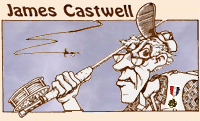|
Let me see if I can get this right. Action is
a word describing something about a fly rod.
There is 'tip Action,' that means the rod is
kind of stiff and the tip is not. The action
is in the tip, probably would also be called
a fast rod. Then there is butt action, the rod
bends clear to the cork, likely be called a
slow or soft rod. We have 'progressive action'
too, the tip flexes and the rod gets stiffer
the farther you go towards the butt. Might be
called a medium-fast rod by some.
Imagine two guys, one new and can hardly get
the line past his shoes and the other an seasoned
angler. Give them the same rod and see what they
will call it. Any guesses on this? Will the new
guy mostly swing the rod, hardly bending it at
all and make big circles of his forward casts?
Since he is not stopping the rod, what will he
call it? A rod that does not bend is a ... right,
it's a fast rod, very stiff.
Now the veteran peels off a fair amount of line,
flips the rod into a back-cast and shoots ten feet
into the front cast. All the time barely moving
the rod. Mostly he is just using the tip and has
not even started to let the rod out. A few more
casts and he has the main part of the line in
the air and making perfect loops at fifty feet.
The rod is flexing at about the mid point and
still he shows no effort.
Finally he rips a couple of double-hauls into
it and a bit of backing hangs out of the tip
guide. Tip action? Mid-flex? Progressive Action?
Full flex? Remember this is the same rod that
the new guy broke a sweat to get to twenty-five
feet with. And he said it was fast! There is a
movement these days for the rod makers to more
correctly identify their rods as to action. Well,
good luck Charlie. I am glad its up to them and
not me.
Subjective seems to come fairly close to the word
I am looking for. Action can be loosely used to
generally describe a rod but then it seems to
fail. Action depends so much on the ability of
the caster. Even worse, as the casters ability
changes so does his ability to make a rod perform.
For instance, a good caster can take a full-flex
(soft?) (slow?) rod and throw tight loops at great
distances. The stroke must be different and much
controlled, but he can do it. In fact, rather easily.
Just as he can make a large front loop and present
a tiny dry like a feather with a fast (stiff?) rod.
Does this mean that all of the rods are mis-marked,
of course not. But, to try to get all up-tight
about them is not necessary either.
The rod that today you think is too stiff, tomorrow
you may find is just right. Or the slow rod you tried
today may become sweet and smooth for you in the
future. Have I gone in circles with all of this?
Yes, at least that was my intention. If you just
want to make little short casts, just flip the tip
of the rod, a quick stop in back and another in
front, make the tip do the work. Longer casts will
require bringing more of the rod into play. The
more you work at it the better you will become
at it. Become friends with your rod, learn how
to make it do your bidding, experiment a bit,
you may find a life long (and versatile) friend. ~ James Castwell
|



